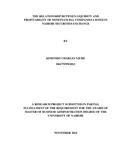| dc.description.abstract | Liquidity management and profitability are very important issues in the growth and
survival of business and the ability to handle the trade-off between the two is of great
concern for financial managers. This study has investigated the relationship between
liquidity and profitability of nonfinancial companies listed in the NSE. The objective of
the study was to establish the relationship between liquidity and profitability of
nonfinancial companies listed in the Nairobi securities exchange. The study adopted a
descriptive research design that enabled the researcher to meaningfully describe a
distribution of scores or measurements using various statistics. The study covered 39
listed nonfinancial companies in NSE Kenya. Analysis was based on data extracted from
audited annual financial statements of listed nonfinancial companies for a period of five
years from year 2009 to 2013. Correlation and regression analysis were employed to
establish the relationship between liquidity and profitability. The ROA was used as proxy
for companies‟ profitability and the companies‟ liquidity was measured using the current
ratio, quick ratio and the absolute liquid ratio. Firm size, sales growth and firms‟ leverage
were used as the control variables. Findings established a significant weak positive
relationship between liquidity and profitability with a Spearman correlation coefficient of
0.398 and R2 of 15.9% among the listed nonfinancial companies in Kenya. However, the
findings are based on a study conducted on the nonfinancial companies listed in the NSE;
hence the results are not generalizable to non-listed companies. Secondly, the sample
only comprises nonfinancial companies. Therefore, the results are not valid for the
financial companies. The study recommends the following for policy and investment
decisions: The trading companies should maintain an optimal liquidity level so as to
maximize company‟s profitability and shareholders‟ wealth. Trading companies should
pursue profit maximization since so doing simultaneously enhances liquidity. Investors
should be guided by the true liquidity and profitability positions of a company in making
their investment decisions. | en_US |

